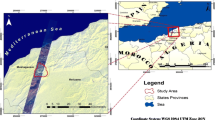Abstract
This paper examines the hyperspectral signatures (in the Visible Near Infrared (VNIR)-Shortwave Infrared (SWIR) regions) of soil samples with varying colour and minerals. 36 samples of sands (from river and beach) with differing clay contents were examined using a hyperspectral radiometer operating in the 350–2,500 nm range, and the spectral curves were obtained. Analysis of the spectra indicates that there is an overall increase in the reflectance in the VNIR-SWIR region with an increase in the content of kaolinite clay in the sand samples. As regards the red and black clays and sand mixtures, the overall reflectance increases with decreasing clay content. Several spectral parameters such as depth of absorption at 1,400 nm and 1,900 nm regions, radius of curvature of the absorption troughs, slope at a particular wavelength region and the peak reflectance values were derived. There exists a correlation between certain of these spectral parameters (depth, slope, position, peak reflectance, area under the curve and radius of the curve) and the compositional and textural parameters of the soils. Based on these well-defined relations, it is inferred that hyperspectral radiometry in the VNIR and SWIR regions can be used to identify the type of clay and estimate the clay content in a given soil and thus define its geotechnical category.











Similar content being viewed by others
References
Ben-Dor E., Goldlshleger N., Benyamini Y., Agassi M., & Blumberg, D. G. (2003). The spectral reflectance properties of soil structural crusts in the 1.2 to 2.5 m spectral region. Soil Science Society of America Journal, 67(1), 289–299.
Bilgili, A. V., Cullu, M. A., van Es, H., Aydemir, A., & Dikilitas, S. K. (2009). Using hyperspectral VNIR spectroscopy for the characterisation of soil salinity, sustainable management of saline waters and salt affected soils for agriculture — Proceedings of the Second Bridging Workshop.
Chang, C. W., Laird, D. A., Mausbach, M. J., & Hurburgh, C. R., Jr. (2001). Near-Infrared eflectance Spectroscopy-Principal components regression analyses of soil properties. Soil Science Society of America Journal, 65, 480–490.
Christy, C. D., & Dyer, S. A. (2006). Estimation of soil properties using a combination of spectral and scalar sensor data. Instrumentation and Measurement Technology Conference, 729–734.
Clark. (1999). Spectroscopy of rocks and minerals, and principles of spectroscopy chapter 1: Spectroscopy of rocks and minerals, and principles of spectroscopy, In Manual of remote sensing, Volume 3, remote sensing for the earth sciences. ASPRS.
Dawson, T. P. (2000). The potential for estimating chlorophyll content from a vegetation canopy using the medium resolution imaging spectrometer. International Journal of Remote Sensing, 21(10), 2043–2051.
Farooq, S. (2012). Spectral reflectance of land covers, Department of Geology, Aligarh Muslim University, Aligarh - 202 002 (India), http://www.cps-amu.org/sf/notes/m1r-1-8.htm.2012.
Fitton, G. (1997). X-ray fluorescence spectrometry. In R. Gill (Ed.), Modern Analytical Geochemistry: An Introduction to Quantitative Chemical Analysis for Earth, Environmental and Materials Scientists (pp. 87–115). Harlow: Addison Wesley Longman Ltd.
Hewson R. D., Cudahy T. J., Jones M., & Thomas, M. (2012). Investigations into soil composition and texture using infrared spectroscopy (2–14 μm) applied and environmental soil science volume 2012, Article ID 535646, 12 pages.
Hunt, G. R. (1977). Spectral signatures of particulate minerals in the visible and near infrared. Geophysics, 42(3), 501–513.
Kaniraj, S. R. (1988). Design aids in soil mechanics foundation engineering. New Delhi: Tata Mc-Graw hill Publishing Company Private Ltd.
Kariuki, P. C. (2003). Spectroscopy and swelling soils—An integrated approach. A thesis work. Delft University of Technology.
Kariuki, P. C., & Van der Meer, F. D. (2003). Swelling clay mapping for characterizing expansive soils; results from laboratory spectroscopy and hysens dais analysis. Presented at the 3rd EARSeL Workshop on Imaging Spectroscopy, Oberpfaffenhofen, May (13–16) 2003.
Lenka V., & Plevove, E. (2005). Identification of Clay Minerals and Micas in Sedimentary Rocks. Geomater, 2(2 (138)), 167–175.
Lucas, Y., & Gagelli, J. (2002). Hyperspectral detection of sand, Seventh International Conference on Remote Sensing for Marine and Coastal Environments, Miami, Florida.
Magendran T., Sanjeevi S., Bhattacharya A. K., Surada S. (2011). Hyperspectral Radiometry to Estimate the Grades of Iron Ores of Noamundi, India — A Preliminary Study. Journal of Indian Society of Remote Sensing, 39(4), 473–483.
Matinfar, H. R., Alavi Panah, S. K., Zand, F., & Khodaei, K. (2011). Detection of soil salinity changes and mapping land cover types based upon remotely sensed data. Arabian Journal of Geosciences, 6(3), 729–734.
Namdar, A. (2010). Mineralogy in Geotechnical Engineering. Journal of Engineering Science and Technology Review, 3(1), 108–110.
Orueta, & Ustin. (1998). Remote Sensing of Soils in the Santa Monica Mountains: II. Hierarchical Foreground and Background Analysis. Remote Sensing of Environment, 68, 138–151.
Rossel, V., Catlle, S. R., Ortega A. S., & Fouad, Y. (2009). In situ measurements of soil colour, mineral composition and clay content byvis–NIR spectroscopy. Geoderma, 150, 253–266.
Rossel V., Chappell A., Caritat P., & McKenzie, N. J. (2010). Mapping the information content of Australian visible-near infrared soil spectra. 19th World Congress of Soil Science, Soil Solutions for a Changing World.
Stenberga, B., Rossel, R. A. V., Mouazen, A. M., & Wetterlind, J. (2010). Visible and near infrared spectroscopy in soil science Advances in Agronomy (Vol. 107, pp. 163–215). Burlington: Academic.
Terzaghi, K., Peck, R. B. & Mesri, G. (1996). Soil mechanics in engineering practice. New York: John Wiley & Sons
Tobias H. K., Dewit J., Buckley S. J., Thurmond J. B., Hunt D. W., & Swennen, R. (2012). Hyperspectral image analysis of different carbonate (limestone, karst and hydrothermal dolomites): the Quarry case study (Cantabria, North-west Spain). Sedimentology, 59, 623–645.
Zhang, T., Li, L., & Zheng, B. (2013). Estimation of agricultural soil properties with imaging and laboratory spectroscopy. Journal of Applied Remote Sensing, 7(1), 073587. doi:10.1117/1.JRS.7.073587.
Author information
Authors and Affiliations
Corresponding author
About this article
Cite this article
Divya, Y., Sanjeevi, S. & Ilamparuthi, K. Studies on Textural and Compositional Characteristics of Sand and Clay Mixtures Using Hyperspectral Radiometry. J Indian Soc Remote Sens 42, 589–600 (2014). https://doi.org/10.1007/s12524-013-0336-6
Received:
Accepted:
Published:
Issue Date:
DOI: https://doi.org/10.1007/s12524-013-0336-6




